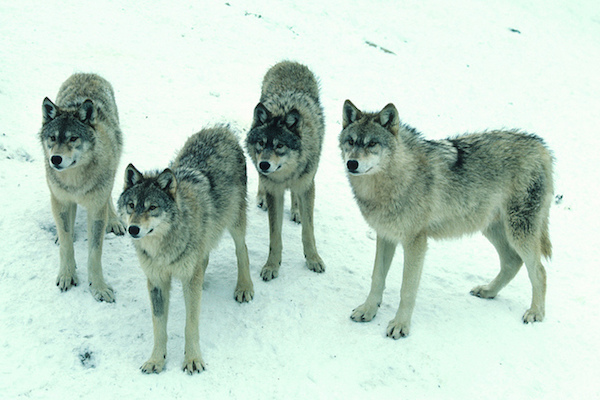Tolerance of wolves in Wisconsin continues to decline

An ongoing University of Wisconsin–Madison study of hunters and others living in the state’s wolf range shows attitudes toward wolves continue to decline.
Photo: Herbert Lange/Wisconsin DNR
Wolf. The very word can conjure an image of a venerable pack of canines passing quietly through moonlit woods. Or, it can evoke anger over livestock lost at the jaws of a hungry predator.
Canis lupus has long been the subject of contention in Wisconsin, and elsewhere, and an ongoing University of Wisconsin–Madison study of hunters and others living in the state’s wolf range shows attitudes toward them continue to decline.
The latest results in this unique longitudinal study, published this month in the journal Environmental Conservation, show that not even the legalization of wolf hunting in 2012 helped improve people’s tolerance of these large carnivores.
“There was a notion held widely in the scientific literature and said at public meetings that a public hunting season would increase acceptance of wolves,” says Adrian Treves, professor in the Nelson Institute for Environmental Studies and co-author of the study. In fact, the Wisconsin Department of Natural Resources cited “maintaining social tolerance” as a goal of the wolf harvest in a statement in 2013.
While wolf hunting is again illegal — the animals were relisted as a federally endangered species in 2014 — study lead author Jamie Hogberg, a researcher at the Nelson Institute, suggests policymakers and wildlife managers might consider other ways to improve social tolerance and reduce conflict between the animals and people going forward.

Hogberg

Treves

Naughton

Shaw
“If we’re going to think about maintaining social tolerance of wolves, the harvest may not be the direct answer to that,” Hogberg says. “It may be useful in other ways but, after the first year, it doesn’t seem to indicate an increase in tolerance.”
The 2012 law authorizing the wolf hunt was a controversial one in Wisconsin but passed quickly once the species was removed from the federal endangered species list. Gray wolves have been relisted and delisted as federally endangered on seven occasions since the early 2000s.
The research team surveyed study participants in April 2013, following the first hunting season.
In preparation, Hogberg enrolled in hunting classes and learned more about hunting culture in Wisconsin, drawing upon her background working with landowners in Montana and the Dakotas.
Geography professor and study co-author Lisa Naughton, who began the initial project in 2001 by creating the Attitude to Wolf Policy Survey, says the study is not anti-hunting. Rather, it “challenges the very simplistic assumptions about what hunting will deliver in terms of favoring wolves,” she says, noting the study is unique in following a large group of people over time.
The 2013 survey drew upon participants who had responded to similar surveys in 2001, 2004 and in 2009. It included hunters, people who had experienced conflict with wolves, and people in and outside of wolf range.
“If we’re going to think about maintaining social tolerance of wolves, the harvest may not be the direct answer to that.”
Jamie Hogberg
Because of the initial study design, the study sample was not representative of Wisconsin as a whole: Over 80 percent of respondents had some experience with hunting, 86 percent were male, and the average age was 55. The participants did, however, represent a key population with respect to wolf tolerance and hunting.
The study measured participants’ feelings toward wolves using ranked measures and a self-report of tolerance. Of the 736 respondents, 36 percent said their tolerance had improved but answers to the ranked portion of the survey indicated a net decline in wolf acceptance among hunters and male respondents. Additionally, more people in 2013 than in 2009 said that the hunt had not increased their tolerance of wolves. About two-thirds approved of the decision to hold the wolf hunt while 12 percent disapproved or strongly disapproved.
Compared with 2009’s survey, more respondents agreed that “killing wolves is the only way to stop them from threatening farm animals and pets” and that wolves “threaten Wisconsin’s deer hunting opportunities.” Fewer respondents believed wolf numbers should be left up to nature and fewer opposed wolf hunting.
Treves isn’t certain whether most hunters in Wisconsin will ever embrace wolves because the predators feed on the white-tailed deer that hunters value.
The study also found that women’s attitudes toward wolves stayed steady, though too few women participated for the researchers to draw statistically significant conclusions.
Treves isn’t certain whether most hunters in Wisconsin will ever embrace wolves because the predators feed on the white-tailed deer that hunters value. He suggests the harvest may have reduced the value of wolves in Wisconsin relative to other game species — permit prices were cut in half after the first year — consistent with findings demonstrated by studies of other large carnivores throughout the world.
However, Hogberg says understanding hunters’ motivations may yield valuable information.
“If people are hunting wolves mostly for the sport of it, like other recreationally valued game species, then they may over time take stock in maintaining their populations and take value in them,” she says. “But if they’re responding more to what they perceive as conflict, or out of aggression or negative feelings, I wouldn’t expect people to become more tolerant if we have more harvest seasons to come.”
“It’s easier to talk about and tally the costs of dead calves than it is to talk about improved populations of endangered plant species or the other ecosystem benefits that come with wolves.”
Lisa Naughton
Additionally, study co-author Bret Shaw, professor in the Department of Life Sciences Communication and a UW-Extension environmental communications specialist, says it’s important to consider Native American perspectives in future research as wolves factor into the creation story of some Wisconsin tribes. They believe their destinies are intertwined.
In addition to having more realistic expectations for what a wolf hunt can achieve, Hogberg advises caution moving forward with wolf hunting, suggesting decision makers approach future harvests more experimentally and design them to better mitigate conflicts, improve attitudes, and increase stewardship.
“We have to figure out how to share the landscape and in the case of large carnivores, so much of that comes down to perception,” says Hogberg.
Which is why, Treves says, messaging matters. Citing an Ohio State University study of bears, he says public acceptance of large carnivores may “hinge rather critically” on whether the benefits of their existence are conveyed. In Wisconsin, this was not practiced concurrently with the wolf harvest, which was framed as a way to reduce wolf populations and decrease human-wolf conflict, Treves says.
Shaw says it’s important to consider Native American perspectives in future research as wolves factor into the creation story of some Wisconsin tribes.
“It’s easier to talk about and tally the costs of dead calves than it is to talk about improved populations of endangered plant species or the other ecosystem benefits that come with wolves,” says Naughton.
While the latest study shows hunting is not the wolf conservation panacea it’s cracked up to be, Treves says people in Wisconsin do appreciate these relatives of man’s best friend, even when they recognize conflict.
“They say: ‘They’re a native animal, I think they’re great, but I just don’t want them eating my calves,’” says Treves. “Wolves are popular, hunting is popular. Let’s not make simplistic assumptions about what’s going to happen when we hunt wolves.”
The study was supported in part by UW-Extension, the UW–Madison College of Agricultural and Life Sciences, and the U.S. Fish and Wildlife Service.


